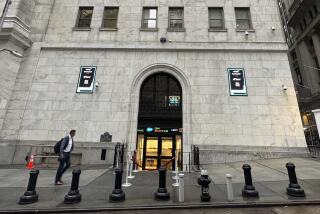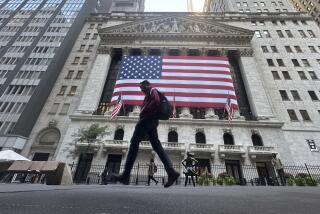Buying Binge in Final Hour Boosts Dow 24.75 to Near-Record Close
NEW YORK — A broad market advance that surged in the last 20 minutes of trading Friday pushed the Dow Jones index of 30 industrial stocks up 24.75 points on heavy trading to a 1,324.48 closing, its second highest mark ever. Analysts attributed the rally to speculation that tobacco company Philip Morris might buy General Foods, whose stock is part of the Dow average, and to the expiration of several stock index and options contracts. Several analysts also said that investors, seeking higher yields, were shifting money out of financial instruments such as certificates of deposit and buying stocks in drug, hospital management or other conservative industries.
The dollar, meanwhile, staged a broad retreat as traders cashed in their profits after the dollar failed to extend a rally that had been touched off Thursday by government reports of renewed economic growth and continued rapid expansion of the money supply.
Trading volume on the New York Stock Exchange was active Friday--about 125.4 million shares, compared to 87.5 million shares Thursday. The Dow index closed within 3 points of the 1,327.28 record that was set June 6, and the daily gain was the year’s second-biggest leap, exceeded only by a 34.01-point gain Jan. 21. It advanced the index 23.52 points for the week.
General Foods Soars
Stefan Abrams, market analyst at Oppenheimer & Co. in New York, said that half of the index’s gain Friday came from a rise in General Foods stock, which closed at 82 3/8, up 10 3/4.
Another big tobacco company, R. J. Reynolds, had agreed to acquire a food company, Nabisco Brands, earlier this month. However, General Foods and Philip Morris denied that they are talking about a merger.
Many analysts said they thought Friday’s rally would be short lived. Underlying uncertainty about the deficit, corporate profits and other economic factors affecting the market remains unchanged, they said. Friday’s rally “will turn out to be a fluke,” said Michael Metz, also at Oppenheimer & Co.
Optimism--fueled by a half-point decline in the prime rate this week to 9 1/2%, the first time the rate has been in single digits since 1978, and by the Commerce Department’s report that the economy is expanding at a 3.1% annual rate in the current quarter versus a 0.3% pace in the first quarter--was dampened by concern about an anticipated fall in corporate profits for the quarter and skepticism about Congress’ ability to cut the federal deficit.
As happens whenever contracts for stock-index futures and options expire, traders tried Friday to lock in profits that they had made on such contracts by buying shares of the stock underlying the index and options. Although the practice helped send shares soaring Friday, the technique can send stocks tumbling, too. On the previous expiration date for such contracts--March 15--the Dow fell 12.70 points, with almost all of the decline coming in the last 30 minutes of trading.
“Much of (Friday’s) gain reflected forces at work within the market, not forces in the real world,” said Andrew J. Melnick of L. F. Rothschild, Unterberg, Towbin.
Abrams at Oppenheimer, however, said he thinks a more fundamental shift in investor spending also helped to fuel the rally.
“You’re seeing a blow-off in the valuation of conservative stocks, and I think it could last some time,” he said. “Think about it as if an investor has a $100,000 CD to roll over and he’s only getting 7.5%. Where’s he going to put it? Not in energy stocks, not in metals, not in manufacturing. He’s going to put it in conservative areas like banking and pharmaceuticals.”
Most-Active Issues
The most-active stocks on the New York Stock Exchange were AT&T;, IBM, General Foods, Hospital Corp. of America and RCA.
AT&T; rose 1/2 to 24 1/2. American Hospital Supply jumped 2 5/8 to 37 after Baxter Travenol offered to buy the company, which previously had agreed to merge with Hospital Corp. of America. Hospital Corp. rose 7/8 to 47 1/2 and Baxter Travenol fell 3/4 to 15 7/8.
Among the market’s blue chips, International Business Machines gained 5/8 to 119 3/8, Exxon rose 1 to 53 and General Motors was up 1 1/8 at 72 3/4.
Fluor was unchanged at 17 after a 1.02-million-share block traded at 17.
For most of the day, the market appeared to be acting with the caution that it had shown through much of the week. Then, with 20 minutes to go before the close of trading, the market rocketed, sending the Dow rise 8 points higher to its closing 24.75.
In the credit markets, bond prices, reflecting the uncertain outlook, declined amid disappointment that a revival in the economy and an acceleration of money supply growth has dimmed chances for a cut in the discount rate, the interest that the Federal Reserve charges on loans to financial institutions.
In the secondary market for Treasury bonds, prices of short-term governments fell point, intermediate maturities were off 1/2 point and long-term issues were down as much as a full point, according to the investment firm Salomon Bros.
Among corporate issues, industrials and utilities fell 3/4 point in light trading. Among tax-exempt municipals, general obligations were off 1/2 point and revenue were down 3/8 point, Salomon Bros. said.
Yields on three-month Treasury bills rose 13 basis points to 7.06%. Six-month bills rose 13 basis points to 7.25%, and one-year bills rose 12 basis points to 7.41%. A basis point is a hundredth of a percent.
Yields on 30-year Treasury bonds rose to 10.58% from 10.49% late Thursday.
The federal funds rate, the interest on overnight loans between banks, was 7.313%, unchanged from late Thursday.
More to Read
Inside the business of entertainment
The Wide Shot brings you news, analysis and insights on everything from streaming wars to production — and what it all means for the future.
You may occasionally receive promotional content from the Los Angeles Times.










